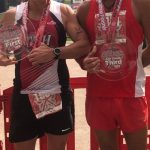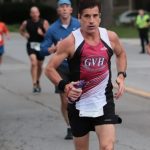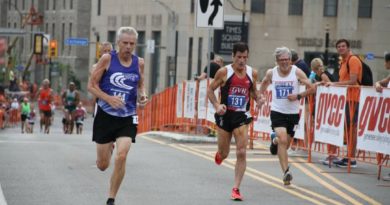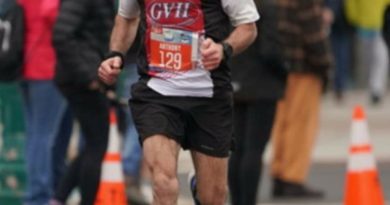How I Set Ambitious Running Goals
We are now in the running season.
Anthony Crilly at Rochester Half Marathon, winning 1st Place in Age Group out of 40, 55 of 2038 runners.

Anthony Crilly, mile 11 on Nations Rd. at Oak Tree Half Marathon September 1, 2019 Geneseo. NY taking 3rd place in Age Group

Running has the power to change your life. It has mine! It will make you fitter, healthier, even happier. With the many 5K,10K, half-marathon races I have run this year alone, there are many on the calendar AND there are many opportunities to join in fun and improve my running times.
So what are some of the things I need to know and do?
All of us have big goals to stay healthy, run more consistently, and set new personal bests. But unfortunately, the majority are short-changing themselves by making silly mistakes. Today I’ll document what I have learned so far and what I am focusing on in my training, so I can get on with the business of achieving more. Better times, zone running, etc to be an elite runner.
But first, to implement some of the things I need to know and do, I must first have a plan. G-O-A-L-S! I need to write down my goals as a committal and sign-off on them as a way to tell my self, “There is No Turning Back!” AND I must stay motivated.
Setting and reaching my goal is an excellent way for me as a runner to stay motivated. While I am in the process of reaching my goal I gain a sense of direction and progression. And when I finally reach my goal I gain a sense of accomplishment and pride.
My running goals are competitive in nature, and they are personal, health-related. So, I have many different types of goals to energize my running program. However, setting smart goals do make the process more valuable.
When defining my running objectives, it helps when I use the SMART method and set goals that are Specific, Measurable, Attainable, Relevant, and Timebound. This SMART goal-setting method is used by coaches, business leaders, educators, and others to help people like me define and reach performance targets.
Specific
My goal is narrow in focus and I avoid generalizations. Yes, I have multiple goals I am targeting at once so they are dove-tailed together. A specific goal is defined by precise terms.
For example, I might want to run faster, but that is a broad and unspecific goal. A specific goal for improving my pace might be “I want to improve my PR in the 1600, 5K, 10K, or half-marathon by 15 seconds or two minutes.” Or if my goal is to participate in a running race for the first time, I identify and sign up for a specific event, like the McMullen Mile Or if I hope to lose 5 lbs. with running to reach ideal running weight, I set a specific goal to lose five pounds in two months by running 5 – 6 days per week or start running double sessions.
A specific goal, though multiple, helps keep me motivated because I know exactly what I need to do to accomplish it. As I move closer to my goal, I get excited and motivated by my progress, so I’ll work even harder to get to that end result.
Measurable
To make my goals measurable, I need to define how I will track my progress and how I will know when I’ve reached my target.
Case in point, if my goal is to run and improve my 1600, 5K, 10K, or half- marathon PR by 15 seconds or two minutes, monitoring my pace during speed work and/or long runs is going to be the smartest way to measure my progress. I use my Garmin pace charts to set specific pace targets for each speed work (200m, 400m, 800m 1200m, etc and long runs, making incremental speed increases each week. I’ll know if I reached my target in the 5K, 10K or on half- marathon race day when I cross the finish line.
Being my goal is to lean-up a few pounds, there are different ways to measure my progress, so I choose a method and use it consistently, like sticking to a regimented food diet, not eating too much of nutritionally-based foods which can be extremely difficult when I have just burned 1500 calories in a run and I’m starving, and staying away from too much protein or fatty, greasy foods.
Case in point, I use a body weight scale, not BMI measurement, nor body fat percentage. This measurement I use often to measure my progress. Measuring my body weight and staying below or at desirable weight goal. Utilizing an example of dropping 15 seconds or 2 minutes to a PR is inconclusive at this point and need to evaluate over a period of time looking at splits, paces, bpm, times results of races. I know that I have reached my goal when I maintain my target run weight.
In defining specific criteria for measurement, it allows me to check my progress periodically and make adjustments as needed. This helps the program seem more manageable so that I stay on track and maintain my motivation.
Attainable
Let’s face it, At this point in my running life, I won’t qualify for the Boston Marathon or run a six-minute mile. So, while it’s good to set lofty running goals, it’s important to choose those that I will be able to accomplish if I’m willing to put in the work. And maybe some day qualify for BM or run a 6 minute mile.
The best goals require me to push myrself outside of my comfort zone, even to the extreme that they are intimidating to me. If a goal is too far out of reach, I am likely to assess, re-evaluate, and analyze because deep down I know that it is not achievable and I must be realistic, patient, and self-controlled.
To figure out if a running goal is attainable, I see how it compares to my previous running achievements. Do I have to make considerable improvements—beyond my ability—to get to that level? If I’m not sure, I talk to my running coach, my endurance coach or both, and elite running friends or those that just beat me to the finish line to help give me a gut check.
Relevant
Just because I’m a runner doesn’t mean I have to set a goal that’s popular among other runners.
For example, many runners set a goal to complete a marathon. But if distance running is more competitive to you, then this goal is not relevant. Henceforth, Ilike half-marathon and enjoying mid-distance runs instead, I set a goal to run a 5K for a local charity that is important to me and at a PB time to ultimately run a sub 20-minute 5k.
As a runner, I participate in the sport for health longevity and the mental health benefits. Decreased BMI, lower blood pressure, or a lower resting heart are all relevant goals for me and all these benefits will come if I focus on the fundamentals.
Like many runners, at times I enjoy running because of the social nature of the sport. A successful goal for me with running was eventually to join and participate in a running group two days each week. Joining Genesee Valley Harriers has taken my running accomplishments and socialization to another level. I have made some great friends in which I don’t think I could have done outside of running.
For a goal to be relevant, it is something that I consider to be worthwhile and important, so I’m willing and able to work towards it. It is personal and meaningful in my life.
Time-bound
I have set a time frame to achieve my goals. Time-bound goals are those that have a deadline. This means that I set and define a time frame for reaching my target.
For example, I ssaid “I want to run a sub 2-hour half marathon”, but I haven’t chosen a specific race, then there’s no sense of urgency for my goal. But if I choose a specific race and say I want to run a sub 1.45:00 half marathon on that specific date, then I can lay out a specific week-by-week program to reach that goal. I reached this goal by running my first half-marathon at 1.44:39. I REACHED MY GOAL! Another example was when I achieved running a sub 23- minute 5k in 2018 and then achieving a sub 22-minute 5k (which was unexpected in 2018). So, reaching a sub 21 -minute 5k and a sub 20- minute 5k are 2019 goals. I never stop setting goals. Once I achieve that goal, I have another in its place.
Setting a deadline kept me motivated and prevented me from getting distracted or wanting to skip workouts. I found that I was even able ready to achieve my running goal by way by running the Flower City Half Marathon course six times before the actual race which helped me become intimate with the course. See Flower City Half Marathon results here:
Since I found that I’m ready to achieve my running goal way ahead of schedule, then I readjust my goal and keep challenging myself towards another goal.
How to Set My Goal
To make my SMART goal setting process more effective, I spend some time considering each of the important factors listed above. It takes many hours or more for me to brainstorm ideas and narrow down my evaluating and re-evaluating each target. But once I have targets set then I focus on it.
I find that journaling helps this process along. Writing out my ideas in notebooks or my blog or even various articles in the process of day-to-day activities is also helpful as I move through the process of reaching my goal(s). I review my notes about why I chose the goal and why it is relevant, or the running accomplishments I considered to determine that my goal is attainable.
Once my goal is established, I write it out and post it in a place where I see it on a regular basis. It serves as a reminder of my commitment and it prompts me to record measurements along the way.
Once I reach my goal, I take notes about how I feel about my accomplishment. I document it by writing an article about it on my blog and share it on social media.Then use that pride as inspiration to set a new goal. A goal that not only inspires me but hopefully inspires others.
Putting My Plan Into Action
This plan takes a few different forms:
NOT ONLY RUNNING
These next two months of running, I will incorporate other forms of training besides running. My legs are constantly being developed, and I started to become a better runner. I am running more and incorporate more cross-training into my schedule. I have included extreme hill repeats and track speed work all while maintaing running 40 miles per week.
Over the last week, I’ve started to discover what it really takes to become a consistent, injury-free runner.
I’ve seen that most beginners flounder with incomplete, haphazard training plans.
With no flexibility or extra guidance about what to do if things get tricky, I’m not surprised that many new runners end up quitting, getting hurt, or never even glimpse their potential.
Not often, I’ve chased complex workouts or shiny new training methods that glossed over the fundamentals. I do runner-specific strength work and sometimes I refuse to give my body the time it needed to recover.
I only realized later that focusing on advanced training strategies was masking the underlying problem: getting the foundational principles (fundamentals) right first!
Once I did that, everything changed.
I realized there are only a few really important aspects of training to focus on – especially as a relative beginner.
And if I get these few fundamental things right, everything else will just fall in place.
Because once the foundation is in place, I have more freedom to chase after my goals:
- Injuries are far less common.
- Motivation is through the roof.
- I’m not distracted by “wishy-washy” training ideas that don’t have a firm footing in the fundamentals.
But even after I got the fundamentals right, I knew that it wasn’t enough to simply KNOW this concept. I needed to to know how to apply it correctly to achieve my goals.
I’ve seen far too many runners fall short of their goals. And instead of being like that, I wanted to be the runner that actually accomplished my big goals to be an elite runner at least in my age group to start.
Getting help from coaches and elite athlete teammates of Genesee Valley Harriers over the past year has helped – a lot. Shying away from opportunities to learn was lesson #1 for me. And after that, my USA Track & Field coaching certification helped formalize those lessons
Most importantly, I’ve learned first-hand from liatening to and watching elite runners since that I can’t just start attacking a big goal on day 1.
The Ladder Technique to Goal-Setting
I have set a progressive approach if I want to be a consistent, successful runner.
I call this approach The Ladder Technique – it helps me tackle a huge goal (like “run my first my half-marathon”) in a smart, incremental way.
I’ve tested this strategy with my running– and the results have been
profound:
“I don’t just feel better; I feel transformed. I’ve never run like this – with strength and without aches and pains. Thank you… once again I’m excited to run and discover what improvements I can make.”
“Once again I owe it all to you. Today was my Half Marathon race and I put all the pieces together. It worked PERFECTLY! I was strong and composed and felt great. For a 54 year old guy who couldn’t run more than 6 miles a year ago, it’s pretty big. I’ll also add, a guy who’s been running injury free since starting.
And today, I want to share this approach with you.
Free Download: The Project: Runner Goal-Setting Worksheet
Instead of an un-systematic way of thinking about goals, this is very specific. You won’t be left saying, “I’d love to be able to run my 5k, 10K, Half Marathon at Personal Best pace without” but then wonder how you’re going to do that…
Spending time on planning has helped get my running on track:
First, I downloaded and completed my Goal Setting Worksheet – this makes my goals concrete.
Notice that I’ve brainstormed BOTH big stretch goals (like “run my first half-marathon” April 28, 2019 1.44:39) and small, daily habits that have helped me achieve these big goals.
Next, I think backwards from my big goal. What are the steps that will help me get there?
Here are a few ideas I have crossed off my bucket list goal like run a half-marathon under one-hour-and-fourty-five-minutes.
- Join an elite running team and train twice a week regular consistent habit.
- Run speed, temp, cut backs training with long runs twice a week
- Improve upon 5K time running a sub 21 minute 5K
- Run your first half marathon and compete regularly in 5K and 10K events
- Run a faster half marathon.
- Run extreme hill repeats
- Run my first marathon.
- Run a 1600 race at 6:20
- Run the Rochester half-marathon!
This process isn’t always linear but this approach gradually gets me from consistent running to crossing the finish line in front of Frontier Field on Morrie Silver Drive..
Like climbing a ladder, each “rung” is closer to my final destination.
Now that I’ve created a “ladder of goals,” I’m ready to get started!

The Next Step
Of course, knowing what my goals are and how to get there are two very different things. Far more than what I can include in an email.
There are other questions to answer:
- What motivation, discipline, and accountability tactics can I use to stay consistent?
- How do I actually train to accomplish my 5K, 10K, Half Marathon time goal?
- What if I get stuck along the way and have questions? Should I resort to googling every random question I have?!
If I want to learn the details and step-by-step answers to these questions, I’ve got great news. This technique is just one tiny part of an entire process that I learn day-by-day.
Until then, I’m challenging you to do just ONE THING in the next 2 minutes.
If you’re a driven to be the best you can be or just getting back into running after a long layoff, then fill out the Goal Setting Worksheet above.
Put those ideas on paper. Make them tangible. Commit to them. And get ready to improve faster than you thought possible.

Let me know in the comments below about your biggest – and smallest – goals. What are you going after this year?
You’ve seen how powerful it can be to focus on the fundamentals. To get your foundation set as you begin your journey as a runner.
It’s transformative – and has the potential to change your life. It has mine!





